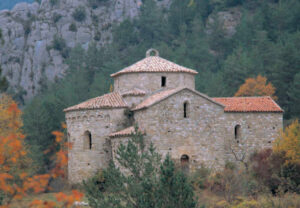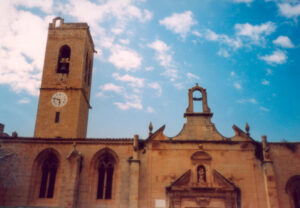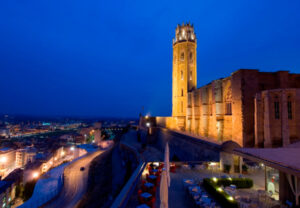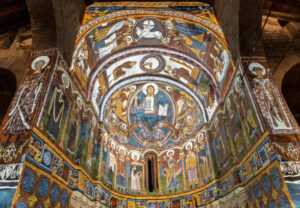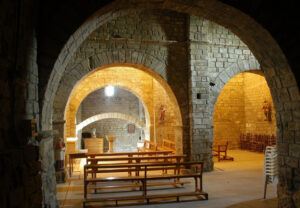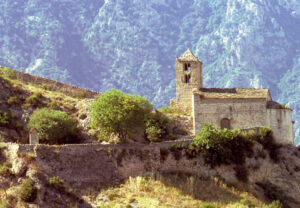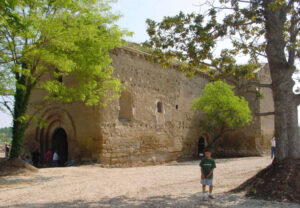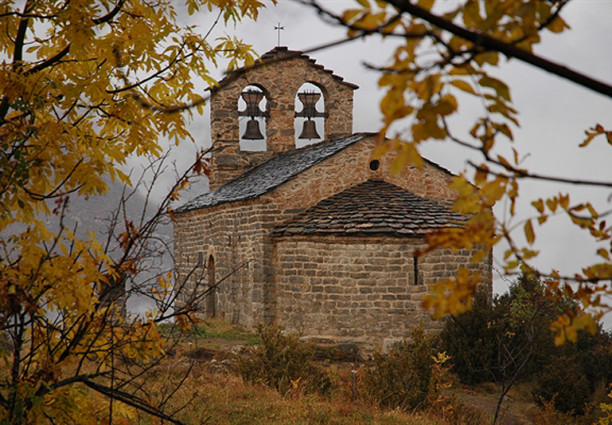
Romanesque route
Year 1000: art and architecture for a new millennium
At the same time that the counties that lie to the south of the Pyrenees broke free from the Empire of Charlemagne, they underwent a deep-seated artistic renovation with the introduction of the Romanesque style which had emerged in the north of Italy in about the year 1000. This then became the main movement in architecture, painting and sculpture in this area until the end of the 13th century when the gothic style began to take over. Although the Romanesque style spread across the whole geography of Lleida, its greatest expression is to be found in the Vall de Boí in the form of a set of nine temples that have been declared a UNESCO World Heritage Site. The Romanesque Centre of the Vall de Boí, located next to the church of Erill-la-Vall, is the place responsible for disseminating information about this and related themes to visitors.
L’Alta Ribagorça. The churches of the Vall de Boí (L’Alta Ribagorça) form the most outstanding set of Romanesque constructions in Catalonia and were declared a UNESCO World Heritage Site in 2000. They include the churches of Boí, Santa Maria and Sant Climent of Taüll, Durro, Barruera and Erill-la-Vall. The Pantocrator (Christ Almighty) of Sant Climent de Taüll is one of the most emblematic elements in the group.
La Val d’Aran. The first surprising feature of the Val d’Aran resides in their characteristic pointed belfries which show a clear Gascon influence. As well as their Romanesque and gothic architecture, the interiors of the churches of Bossòst, Vielha, Escunhau, Arties, Tredòs, Salardú and Unha also house extensive sets of mural paintings and relevant works of Romanesque imagery, including the Christ of Mijaran and the Holy Cross of Salardú.
El Pallars Sobirà. Romanesque church of Sant Joan of Isil. Group of Romanesque buildings of Son del Pi (church of Sant Just i Sant Pastor of Son). Church and Romanesque paintings of Sant Pau i Sant Pere of Esterri de Cardós. Church, engravings and paintings of Santa Maria of Ginestarre. Romanesque-style hermitage of Santa Eulàlia of Alendo. Monastery of Sant Pere de Burgal, Escaló. Church of Santa Maria of Àneu. Romanesque church of Sant Iscle i Santa Victòria of Surp. Romanesque church of Santa Maria of Ribera de Cardós. Monastery of Santa Maria of Gerri de la Sal. Hermitage of Nostra Senyora d’Arboló.
El Pallars Jussà. Historic group of Mur: castle and religious community of Santa Maria. Historic group of Llordà: castle and religious community of Sant Sadurní. Churches of the Vall Fosca: Sant Vicenç of Capdella, Sant Martí of La Torre de Capdella and Sant Julià of Espui. Church of Santa Maria of Covet. Church of the Verge dela Cinta of Llimiana. Church of Sant Esteve of Abella de la Conca.
La Cerdanya. Group of relatively small buildings amongst which the most outstanding are the former religious community of Santa Maria of Talló and the parish church of Sant Pere of Alp.
L’Alt Urgell. La Seu d’Urgell: cathedral of Sant Maria, church of Sant Miquel and the Diocesan Museum. Castellbò: collegiate church of Santa Maria. Estamariu: church of Santa Maria. Organyà: collegiate church of Santa Maria. Coll de Nargó: church of Sant Climent. Valldarques: church of Sant Romà. Oliana: chapel of Sant Andreu. Peramola: Mare de Déu of Castell-llebre. Anserall: Sant Serni of Tavèrnoles. Sant Maximí of Sallent. Sant Joan of Montanissell. Sant Romà of Valldarques. Sant Martí of La Plana. Sant Miquel de les Masies of Nargó. Sant Serni of Gavarra.
La Noguera. Camarasa: watchtower and church of Baronia de Sant Oïsme. Àger: collegiate church of Sant Pere. Les Avellanes: church of Santa Maria. Cubells: church of El Castell. Balaguer: monastery of Santa Maria de les Franqueses. La Baronia de Rialb: monastery of Santa Maria of Gualter, Santa Maria of Palau, Sant Iscle i Santa Victòria of La Torre and Sant Andreu of El Puig. Ponts: collegiate church of Sant Pere.
El Solsonès. Solsona: cathedral of Solsona (apse and belfry), Marededéu del Claustre, paintings of Pedret, virgins, capitals and iconographic representations at the Diocesan and local District Museum of Solsona. Olius: church and crypt of Sant Esteve. Sant Llorenç de Morunys: church and cloister of the former monastery. Navès: church of Sant Pere de Graudescales, church of La Móra Comdal and Romanesque bridge of the Vall d’Ora. Clariana de Cardener: churches of Santa Àgata and Sant Martí of Joval. Guixers: churches of Sant Serni of El Grau, Santa Creu of Els Ollers and Sant Martí of Guixers and the Romanesque bridge of Vall-llonga. Pinell de Solsonès: church and walled settlement of Sant Climenç and church of Sant Pere of Madrona. Castellar de la Ribera: church of Sant Julià of Ceuró. Lladurs: churches of Santa Eulàlia of Timoneda and Sant Sadurní of La Llena. Llobera: churches of Santa Maria of Torredenagó, Santa Maria of Montraveta and Sant Pere of Llobera. La Coma i la Pedra: churches of Sant Quirze, Santa Julita of La Coma, Sant Sadurní of La Pedra, Santa Magdalena of Les Tragines, Sant Cristòfol of Els Pasqüets, Sant Lleïr of Casavella and Santa Creu of El Roser.
El Segrià. Lleida: cathedral of La Seu Vella, church of Sant Llorenç, church of Sant Martí, La Paeria (City Council building).
Les Garrigues. Church of Granyena. Church of Sant Joan Baptista, Vinaixa. Hermitage of Sant Salvador, Les Borges Blanques. Romanesque portal of Bovera. Chapel of Sant Miquel de les Borgetes, Arbeca. Church of Santa Maria, Fulleda.
L’Urgell. Agramunt: church of Santa Maria. Vallbona de les Monges: Cistercian monastery of Santa Maria. Tàrrega: palace of the marquises of La Floresta. Maldà: church of Sant Pere. Verdú: castle and church of Santa Maria. Vilagrassa: monumental portal of the church of Santa Maria.
La Segarra. Cervera: church of Sant Pere el Gros, monumental portal of Sant Martí of the church of Santa Maria. Massoteres: Sant Pere of Talteüll. Els Plans de Sió: Sant Esteve of Pelagalls and Sant Salvador of Concabella. Torà: church of the former monastery of Cellers. Les Oluges: Sant Pere of Santa Fe. Talavera: Sant Jaume of Pallerols. Torrefeta i Florejacs: Sant Julià of El Llor.
